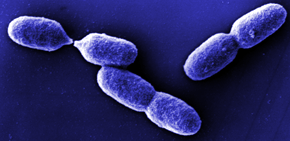Azotobacter |
| Experiment |
Azotobacter Experiments as Bio Fertilizer -
 The field soils are inhabited by a very large number of microbial species. The co-existence of the relative
populations of each one of the species is determined by ecological factors prevailing in
the soil. These various species survive in soil while maintaining a balance of population
is between various microbial species within certain limits.
In order to obtain most efficient strains of Azotobacter one has to conduct different tests or experiments in
glass house, earthern pots and field under the guidance of micro-biologists, some of them
are explained below;
The field soils are inhabited by a very large number of microbial species. The co-existence of the relative
populations of each one of the species is determined by ecological factors prevailing in
the soil. These various species survive in soil while maintaining a balance of population
is between various microbial species within certain limits.
In order to obtain most efficient strains of Azotobacter one has to conduct different tests or experiments in
glass house, earthern pots and field under the guidance of micro-biologists, some of them
are explained below;
|
| Azetylene reduction Test - : Different strains of Azotobacter in Pure form are grown in the laboratory in separate conical flasks. These flasks are then kept on shaker for about 72-50 hours so as to obtain full growth of bacteria in the medium of which 10-15 ml.,of both is transferred to a bottle, to this bottle 10 ml of acetylene gas is added and bottle is closed with cork borer and allowed to stand in the shed for 2-4 hours to have reaction of enzyme nitrogenase with acetylene gas. During this period, acetylene is converted to ethylene. Percentage of both the gases is measured chromatographically. The strain which has more nitrogenase enzyme forms more ethylene gas. Naturally, this strain will be selected for further use. |
| Pot culture experiment - : After having tested different strains in the laboratory and selected efficient strains next test comes the pot culture experiment. In this test, earthern pots are cleaned properly and disinfected with some common laboratory disinfectent and filled in with uniform amount of garden soil already sterilized. Strain found efficient in acetylene reduction test are selected and multiplied in a pure form. The broth is mixed with liquite and inoculant so prepared is used to inoculate the seeds. Seeds are then dried in shed and sown in pots. Suitable inoculated control plants are kept for comparision. Plants are watered as and when required and allowed to grow for about 45-60 days. Differences between inoculated and uninoculated plants in respect of height, nitrogen content of plant and soil, dry weight of plants are noted. Efficient strains are used for field tests. |
| Field Test : Strains found
efficient under glass house conditions are required to undergo field test which is most
important test from the farmers point of view. Strains found efficient in glass
house and acetylent tests when used in field are required to compete with native flora for
their nutrition. Efficient strains of Azotobacter are applied to seeds of particular and
sown. An adequate control is kept for comparision. All other factors are kept similar
except seed inoculation with efficient strains of Azotobacter.
After maturity yield
figures are noted and comparision is made. Such experiments are repeated for 3 to 4 years
at different places. From this data an efficient strain is selected and used for the
production of Azotobacter on a large scale. Such strains are stored under cold storage
conditions or in refrigerator. For production of bio-fertilizer, it is always advisible to
use more than one strain on safer side. - - Experience of biofertilizer: - Field experiments using Azotobacter as a biofertilizer for wheat, barley, oat maize, sugarcane, etc. revealed that the performance of Azotobacter was medium to poor. Experiments on the use of Azotobacter for seed inoculation of various crops have also been conducted in other countries including India. The results of these experiments indicate that benefits obtained from inoculation of seeds with biofertilizer were marginal in soil with poor organic matter content. While in rich soils results were quite encouraging. |
| Azotobacter Experiment Conclusions:
It improves seed germination and plant growth Azotobacter are tolerant to high salts. It can benefit crops by Nitrogen fixation, growth promoting substances, fungi static substances. Azotobacter is heaviest breathing organism and requires a large amount of organic carbon for its growth. It is poor competitor for nutrients in soil and hence its growth promoting substances, fungistatic substances. It thrives even in alkaline soils. Azotobacter is less effective in soils with poor organic matter content. |
| New technique in Biofertilizer - Generally biofertilizers are carrier based and always in powder form. The carrier is mostly lignite, which has high organic matter content, and it holds more than 200% water, which enhances the growth of the micro-organisms. Before use slurry is made which is applied to seed. This method is universal unless it has some difficulty in application to seed no other method is used. Recently university of agricultural sciences, Bangalore has developed a method- dry complex fertilizer for direct soil application. This method consists of granules (1-2 mm) made from tank bed clay (TBC). These granules are baked at 2000C in a muffle furnace, which helps to sterilize the material and gives porosity to granules. The baked granules are soaked in a suspension of nitrogen fixing bacteria grown in a suitable medium overnight. The clay granules are air dried at room temperature under aseptic conditions. The granules contain more than a billion of bacteria per gram of granules. These granules are suitable for field application along with seeds and fertilizers in furrows. However, quantity of biofertilizer to be applied will be slightly higher than seed application. |